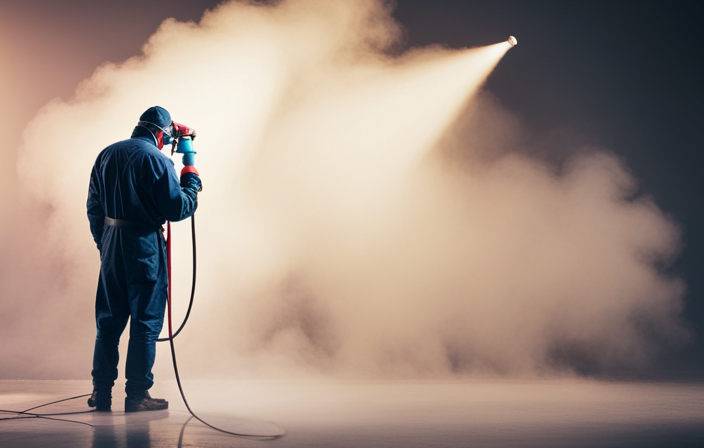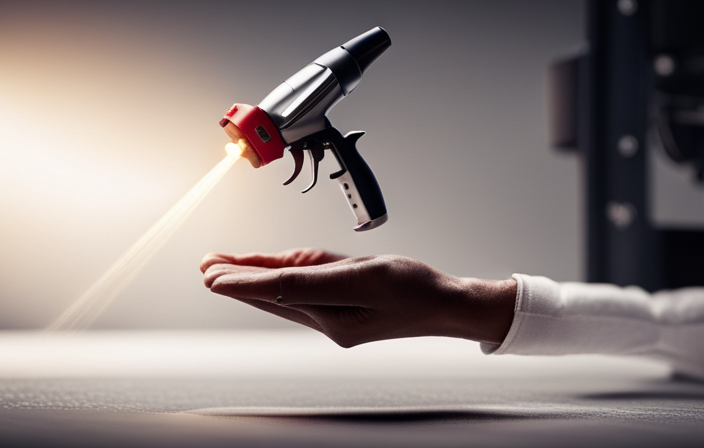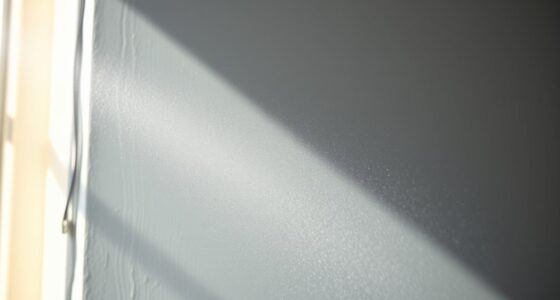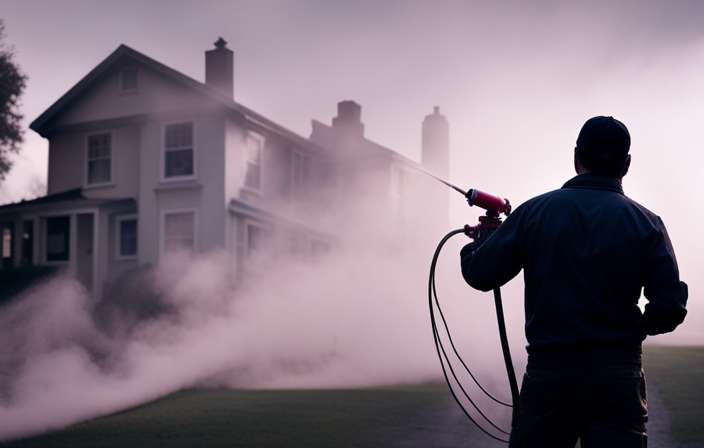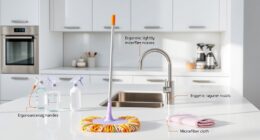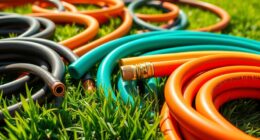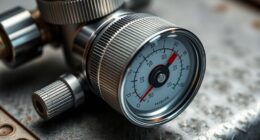Tired of the slow and tedious task of painting? I have a solution for you – the airless paint sprayer! This incredible tool will revolutionize your painting process, making it faster, easier, and much more effective than you could imagine. Trust me, once you try it, you won’t even consider going back to traditional brushes.
In this video, I’ll guide you through the process of running an airless paint sprayer, providing you with all the knowledge and techniques you need to achieve professional-looking results. From understanding the components of the sprayer to choosing the right paint and properly cleaning up afterwards, I’ll cover it all.
So, if you’re ready to take your painting game to the next level, grab your airless paint sprayer and join me in this video tutorial. Get ready to transform your space with ease and precision, all thanks to the power of the airless paint sprayer.
Let’s get started!
Key Takeaways
- Benefits of airless paint sprayers: faster and easier painting, even coverage, efficient for large areas and thick coatings, professional finish without brush strokes or roller marks
- Proper techniques for using an airless paint sprayer: hold sprayer 12 inches away from surface, move in smooth, continuous motion, overlap each stroke by 50%, grip handle firmly, maintain consistent distance from surface
- Safety tips and precautions: wear protective gear, properly maintain equipment, select appropriate respiratory protection, ventilate the area, cover nearby furniture and surfaces, clean the sprayer after each use
- Proper cleaning and storage of the sprayer: prepare a cleaning solution, disassemble and soak removable components, flush out the sprayer, clean and dry all components before storage, check seals and gaskets regularly, store in a clean, dry, and well-ventilated area
Introduction to Airless Paint Sprayers
Now let’s dive into the world of airless paint sprayers and discover how you can effortlessly transform your space with a smooth and flawless coat of paint.
Airless paint sprayers are a revolutionary technology that use high pressure to atomize the paint, resulting in a fine mist that evenly covers surfaces. One of the major advantages of using an airless paint sprayer is its efficiency. It can cover large areas quickly and can handle thick coatings with ease.
Additionally, airless sprayers provide a professional finish with no brush strokes or roller marks. However, there are some drawbacks to consider. They can be expensive to purchase and maintain, and they can also create a significant amount of overspray.
Understanding the components of an airless paint sprayer will help you make the most out of this powerful tool.
Understanding the Components of an Airless Paint Sprayer
First, let’s take a look at the different parts that make up an airless paint sprayer. The main components of an airless paint sprayer include the motor, pump, hose, and gun. These parts work together to ensure a smooth and efficient painting experience.
Understanding nozzle sizes is crucial when using an airless paint sprayer. Different nozzle sizes determine the width of the spray pattern and the amount of paint that’s released. Choosing the right nozzle size for your project is essential to achieve the desired results.
Troubleshooting common issues is also an important skill to have when using an airless paint sprayer. Some common issues include clogging, uneven spray pattern, and inconsistent pressure. By understanding how to identify and troubleshoot these issues, you can save time and ensure a successful painting job.
Now that we have a good understanding of the components of an airless paint sprayer and how to troubleshoot common issues, let’s move on to preparing your work area and surface for painting.
Preparing Your Work Area and Surface
To ensure a successful painting project, start by clearing your work area of any obstacles and protecting nearby furniture and floors with drop cloths. Work area organization is key to maintaining a smooth workflow and minimizing any potential accidents or mishaps.
Take the time to remove any furniture or objects that may be in the way and make sure to cover them with drop cloths to prevent any accidental splatters or spills. Additionally, it’s essential to properly prepare the surface you’ll be painting. This may involve cleaning the surface, removing any loose paint or debris, and applying a primer if necessary.
By following these surface preparation techniques, you can ensure that your paint job will adhere properly and provide optimal results.
Now, let’s move on to choosing the right paint and diluting if necessary.
Choosing the Right Paint and Diluting if Necessary
When selecting the ideal paint for your project, it’s crucial to consider factors such as color, finish, and durability. This ensures a stunning end result that will stand the test of time.
Start by choosing paint colors that complement your space and evoke the desired mood. Take into account the lighting and existing decor to make an informed decision.
To estimate the paint quantity needed, measure the square footage of the area to be painted and refer to the paint manufacturer’s coverage specifications. It’s always a good idea to buy a little extra to account for touch-ups or future use.
If needed, dilute the paint according to the manufacturer’s instructions, making sure to maintain the desired consistency.
With the right paint selected and prepared, let’s move on to the subsequent section about proper techniques for using an airless paint sprayer.
Proper Techniques for Using an Airless Paint Sprayer
Mastering the art of using an airless paint sprayer will elevate your painting skills to a whole new level, allowing you to effortlessly create professional-looking finishes with ease.
To achieve a smooth finish, it’s crucial to hold the sprayer correctly and utilize proper techniques. Here are three key points to keep in mind:
-
Maintain a consistent distance: Hold the sprayer approximately 12 inches away from the surface you’re painting. This ensures an even application and prevents overspray.
-
Keep a steady pace: Move the sprayer in a smooth, continuous motion at a moderate speed. Avoid pausing or dwelling on one area, as it can result in uneven coverage.
-
Overlap each stroke: To achieve a seamless finish, overlap each stroke by 50%. This helps blend the paint and eliminate any visible lines or streaks.
By implementing these techniques, you’ll be able to achieve a professional-looking finish with your airless paint sprayer. Holding the sprayer correctly is just the first step towards creating stunning results.
Holding the Sprayer Correctly
Holding the sprayer in the correct position is like finding the key to unlocking a world of flawless finishes. Proper hand position is crucial for maintaining control and achieving professional results.
To hold the sprayer correctly, grip the handle firmly with one hand, while using the other hand to support the weight of the sprayer. This will help you maintain a steady rhythm and prevent hand fatigue during long painting sessions. Keep your wrist straight and your arm relaxed to ensure smooth movements. By following these simple tips, you can achieve a steady and even paint application.
Now that we’ve covered holding the sprayer correctly, let’s move on to maintaining a consistent distance from the surface.
Maintaining a Consistent Distance from the Surface
Achieving a flawless finish requires maintaining a consistent distance from the surface while operating the sprayer. By keeping a steady distance, you can ensure an even application of paint without any splatters or uneven spots. To help you visualize the proper distance, refer to the table below:
| Distance from Surface | Effect on Paint Application |
|---|---|
| Too Close | Heavy and uneven coverage |
| Optimal Distance | Smooth and even coverage |
| Too Far | Thin and patchy coverage |
Maintaining the right distance is crucial to avoid wasting paint and achieving professional-looking results. It may take some practice to find the sweet spot, but it is worth the effort. Once you have mastered the art of maintaining distance, you can move on to the next step of overlapping strokes for even coverage.
Overlapping Strokes for Even Coverage
To ensure a flawless finish, you need to understand the importance of overlapping strokes for even coverage. When using an airless paint sprayer, overlapping strokes are crucial in achieving a smooth finish and minimizing overspray.
By applying each stroke slightly overlapping the previous one, you ensure that the paint is evenly distributed across the surface. This technique helps to eliminate any gaps or inconsistencies in the paint application, resulting in a professional-looking finish. It’s important to maintain a consistent speed and distance from the surface while overlapping the strokes to avoid any patchiness or streaks.
By following this method, you can achieve a seamless and uniform coat of paint.
Moving forward, let’s discuss some safety tips and precautions to keep in mind while operating an airless paint sprayer.
Safety Tips and Precautions
Make sure you follow these safety tips and precautions to ensure a smooth and worry-free experience while using an airless paint sprayer. Safety precautions are essential when using any type of equipment, including an airless paint sprayer.
First, always wear protective gear such as goggles, gloves, and a mask to protect yourself from potential hazards.
Second, make sure to properly maintain your equipment by regularly cleaning it and checking for any damage or leaks. This will not only prolong the lifespan of your sprayer but also ensure that it functions properly and safely.
Remember, safety should always be your top priority when using an airless paint sprayer.
Now let’s move on to the next section about wearing protective gear.
Wearing Protective Gear
Now that we’ve covered the importance of safety tips and precautions, let’s dive into the next crucial aspect of running an airless paint sprayer: wearing protective gear. When it comes to operating a paint sprayer, selecting appropriate respiratory protection is essential to protect yourself from inhaling harmful fumes and particles. This can include using a respirator mask with the right filter cartridges that can effectively filter out paint particles and volatile organic compounds (VOCs). Additionally, eye protection is equally important to shield your eyes from paint overspray and any potential debris. Wearing safety goggles or a full-face shield can prevent eye injuries and ensure clear vision throughout the painting process. As we move forward, we will now discuss the next step: ventilating the area to further enhance safety and efficiency.
Ventilating the Area
Ensure a safer and more enjoyable painting experience by properly ventilating the area before starting. Proper ventilation is essential to prevent the buildup of fumes and ensure good air quality. Before beginning, make sure all windows and doors are open to allow for proper airflow. If there’s no natural ventilation, consider using fans or other mechanical ventilation systems.
It’s also important to wear a respirator to protect against harmful chemicals in the air. Additionally, take safety precautions such as covering nearby furniture and surfaces to prevent paint overspray. By following these steps, you can create a well-ventilated environment that minimizes health risks and allows for a smoother painting process.
Moving on to the next section on cleaning and maintaining the sprayer, it’s important to keep the equipment in good condition for future use.
Cleaning and Maintaining the Sprayer
First things first, let’s give the sprayer a good scrub to keep it in top-notch shape for future projects. Cleaning an airless paint sprayer is crucial to ensure its longevity and optimal performance.
Here are three effective cleaning techniques to prevent rust and maintain the sprayer’s functionality:
-
Thoroughly rinse the sprayer with clean water after each use. This removes any leftover paint residue and prevents clogging in the nozzle.
-
Use a mild detergent solution to clean the sprayer’s components, such as the nozzle, filters, and hoses. Gently scrub them with a soft brush to remove any stubborn paint buildup.
-
Regularly inspect the sprayer for any signs of rust or corrosion. If you spot any, remove it using a rust remover and apply a rust-resistant coating to protect the sprayer’s metal parts.
By following these cleaning techniques, you can keep your airless paint sprayer in excellent condition. Now, let’s move on to troubleshooting common issues that may arise during your painting projects.
Troubleshooting Common Issues
If you encounter any problems while using your airless paint sprayer, troubleshooting common issues can help you overcome them and achieve a flawless finish. Here are some common problems with paint sprayers and how to troubleshoot them:
| Problem | Possible Cause | Solution |
|---|---|---|
| No spray or uneven spray pattern | Clogged tip or filter | Clean or replace the tip and filter |
| Paint spitting or sputtering | Paint viscosity is too high | Thin the paint or adjust the pressure |
| Motor not running | Power supply issue | Check the power cord and outlet |
| Excessive overspray | Incorrect spray tip size | Use the appropriate tip for the paint type |
| Paint leaking from the sprayer | Loose or damaged fittings | Tighten or replace the fittings |
By following these troubleshooting steps, you can easily address common problems with airless paint sprayers and ensure a smooth painting experience. Now, let’s move on to the next section on clogging or dripping.
Clogging or Dripping
Addressing clogging or dripping issues can save you time and frustration when using your airless paint sprayer. To prevent clogging, it’s important to properly strain your paint before pouring it into the sprayer. This’ll remove any debris or clumps that could potentially clog the nozzle.
Additionally, using the correct tip size for your paint viscosity will help minimize clogging. If you notice dripping, check the sprayer’s pressure settings. Adjusting the pressure can help control the flow of paint and prevent dripping.
It’s also important to maintain a consistent distance from the surface while spraying to avoid excessive buildup and dripping. By following these steps, you can prevent clogging and minimize dripping, ensuring a smooth and even spray pattern for your painting project.
Uneven Spray Pattern
To achieve a groovy and even spray pattern, make sure to maintain a consistent distance from the surface while using your airless paint sprayer. Improper technique can lead to an uneven spray pattern and inadequate paint coverage. Here are some tips to avoid these issues:
- Hold the sprayer parallel to the surface and keep it at a distance of around 12 inches.
- Move the sprayer in a slow and steady motion, overlapping each pass by about 50%.
- Avoid excessive spraying in one area, as it can result in unevenness.
By following these guidelines, you can ensure a smooth and consistent paint application.
In the next section, we’ll discuss another common problem with airless paint sprayers: loss of pressure.
Loss of Pressure
To address the issue of an uneven spray pattern, it’s important to understand the potential causes and troubleshooting solutions. However, a related problem that can also affect the quality of your paint job is a loss of pressure in your airless paint sprayer. This can lead to an inconsistent spray and unsatisfactory results. To prevent a loss of pressure, there are a few key steps you can take. Firstly, make sure that your sprayer’s filters are clean and free from debris, as clogs can restrict the flow of paint and reduce pressure. Additionally, check that your spray tip is properly sized for the material you are using, as using the wrong size can result in pressure loss. Regular maintenance and cleaning of your equipment will also help to prevent issues with pressure. By following these troubleshooting solutions and taking preventative measures, you can ensure a consistent and high-quality spray pattern.
Moving forward, let’s explore some tips for achieving a professional finish.
Tips for Achieving a Professional Finish
For a flawless and polished result, you’ll need to master these essential tips to achieve a professional finish.
Here are four key strategies to help you achieve a smooth finish and avoid overspray:
-
Proper preparation: Before you start painting, make sure to clean the surface thoroughly and remove any loose debris or dirt. This will ensure that the paint adheres smoothly and evenly.
-
Use the right technique: Hold the sprayer at a consistent distance from the surface, usually around 12 inches. Move the sprayer in a steady back-and-forth motion, overlapping each pass slightly to avoid streaks or lines.
-
Adjust the pressure: Experiment with different pressure settings to find the sweet spot that gives you the best coverage without excessive overspray. Start with a low pressure setting and gradually increase it until you achieve the desired result.
-
Practice makes perfect: Before tackling a large project, practice on a small, inconspicuous area to get a feel for the sprayer and perfect your technique.
By following these tips, you’ll be well on your way to achieving a professional finish.
Next, let’s dive into the importance of applying multiple coats.
Applying Multiple Coats
If you’re wondering why applying multiple coats is necessary, let me assure you that it’s the key to achieving a flawless and long-lasting finish.
When using an airless paint sprayer, it’s crucial to apply thin coats rather than thick ones. This allows for better control and prevents drips or uneven coverage. Additionally, applying multiple coats ensures that the paint adheres properly to the surface, resulting in a more durable finish.
To estimate the drying time between coats, it’s important to follow the manufacturer’s instructions on the paint can. Factors such as temperature and humidity can also affect drying time, so it’s essential to take those into consideration.
Once the previous coat is dry to the touch, you can proceed with applying the next coat. This will provide a smooth and professional result.
Moving on to the next section about using a primer, it’s an essential step to prepare the surface before applying the paint.
Using a Primer
Now that we’ve discussed applying multiple coats, let’s move on to the next step: using a primer. A primer is an essential part of the painting process as it provides a smooth base for the paint to adhere to, ensuring better coverage and durability. While most people use an airless paint sprayer for applying paint, using a brush to apply a primer can be beneficial in certain situations. It allows for more precise application, especially in tight corners or intricate areas. However, if you prefer to use the airless paint sprayer for priming as well, there are alternative methods such as thinning down the primer to a suitable consistency for the sprayer. This can save time and effort, but make sure to follow the manufacturer’s instructions for proper dilution. Moving forward, let’s delve into the next section where we will discuss practicing on scrap materials.
Practicing on Scrap Materials
Priming with a brush allows for more precise application, especially in tight corners or intricate areas, which can greatly enhance the overall quality of the painting.
When practicing techniques with an airless paint sprayer, it’s important to choose the right materials to work on. Here are three key factors to consider:
-
Start with scrap materials: Using scrap materials allows you to experiment and perfect your technique without worrying about ruining a finished project. This gives you the freedom to try different spray patterns, adjust the pressure, and get comfortable with the sprayer.
-
Use different surfaces: Practice on a variety of surfaces, such as wood, metal, or plastic, to understand how the sprayer performs on each material. This will help you determine the best settings and techniques for different projects.
-
Test different paint types: Try spraying different paint types, such as latex or oil-based, to see how they behave with the sprayer. This will allow you to understand their viscosity and adjust the sprayer accordingly.
Now that you’ve practiced on scrap materials and mastered your technique, it’s time to move on to the next step: cleaning up after using an airless paint sprayer.
Cleaning Up After Using an Airless Paint Sprayer
After using an airless paint sprayer, cleaning up is as important as the final strokes on a masterpiece. It requires meticulous attention to detail. To ensure a thorough clean, I start by preparing a cleaning solution according to the manufacturer’s instructions. This usually involves diluting a specific cleaning agent with water.
Next, I carefully disassemble the sprayer, taking care not to damage any delicate parts. I soak the removable components in the cleaning solution for a recommended amount of time to loosen any paint residue. Once soaked, I use a brush to scrub away any remaining paint.
It’s crucial to dispose of the cleaning solution properly, as it may contain harmful chemicals. I always follow local regulations for safe disposal.
With the cleaning complete, I transition into the next step of flushing out the sprayer.
Flushing Out the Sprayer
To ensure your sprayer continues to perform at its best, the next step is to thoroughly flush out all the remaining paint residue. This is a crucial step in maintaining the longevity of your equipment and preventing any clogs or blockages.
Start by removing the spray tip and guard, and then attach a clean bucket to the sprayer’s intake tube. Fill the bucket with a cleaning solution specifically designed for airless sprayers.
Turn on the sprayer and let the cleaning solution circulate through the system, flushing out any paint residue. Once the solution runs clear, you can remove the bucket and reattach the spray tip and guard.
Properly storing the equipment is the next important step in ensuring its longevity and preventing any damage.
Properly Storing the Equipment
After flushing out the sprayer, it’s important to properly store the equipment to ensure its longevity and continued functionality.
Storing your airless paint sprayer correctly will not only protect it from damage but also make it easier to use in the future. Start by cleaning all the components thoroughly and making sure they’re completely dry.
Store the sprayer in a clean, dry, and well-ventilated area to prevent rust or corrosion. It’s also a good idea to cover the equipment with a cloth or plastic bag to keep it dust-free.
Regular equipment maintenance, such as checking for any leaks or clogs, should be done before storing the sprayer.
By taking these steps, you can ensure that your airless paint sprayer will be ready for use whenever you need it.
Now, let’s move on to the conclusion and final thoughts.
Conclusion and Final Thoughts
In wrapping up, it’s important to ensure that your equipment is properly stored and maintained so that it remains in top-notch condition for all your future painting projects.
Here are three essential tips for troubleshooting common issues and best practices for achieving a smooth finish:
-
Clean the sprayer thoroughly after each use to prevent clogs and buildup. Use warm, soapy water and a soft brush to remove any paint residue from the nozzle, hose, and other components.
-
Check the seals and gaskets regularly to ensure they’re tight and not damaged. Replace any worn-out parts to prevent leaks and maintain optimal performance.
-
Store the airless paint sprayer in a clean, dry area away from extreme temperatures. Use the manufacturer’s recommended storage method, such as hanging it on a wall or placing it in a protective case, to prevent damage and prolong its lifespan.
By following these tips and best practices, you can keep your airless paint sprayer running smoothly and achieve professional-quality results with every project.
Frequently Asked Questions
How do I troubleshoot common issues with an airless paint sprayer?
To troubleshoot common issues with an airless paint sprayer, follow these maintenance techniques and troubleshooting tips. Check for clogged nozzles, ensure proper pressure settings, clean or replace filters, and inspect the pump for any leaks or malfunctions.
What should I do if the sprayer is clogging or dripping?
If the sprayer is clogging or dripping, first, I would clean the sprayer thoroughly to remove any paint residue. Then, I would adjust the nozzle to ensure a proper spray pattern and prevent any further issues.
How can I fix an uneven spray pattern?
To fix an uneven spray pattern with an airless paint sprayer, I would adjust the nozzle by turning it clockwise or counterclockwise until the desired pattern is achieved. It’s also important to maintain the correct spraying distance to prevent overspray.
What should I do if I experience a loss of pressure while using the sprayer?
If I experience a loss of pressure while using the sprayer, I’ll troubleshoot by checking for clogs, ensuring proper nozzle size, and adjusting the pressure settings. Maintaining an even spray is crucial, so I’ll be meticulous and thorough.
What are some tips for achieving a professional finish with an airless paint sprayer?
To achieve a professional finish with an airless paint sprayer, it’s crucial to use proper technique. Start by ensuring the surface is clean and smooth, then apply thin coats with even strokes, overlapping each pass for a seamless result.
Conclusion
In conclusion, using an airless paint sprayer can greatly simplify the painting process and provide professional results. By understanding the components and properly preparing your work area, you can achieve a smooth and even finish.
Choosing the right paint and diluting if necessary is crucial for optimal performance. Mastering the proper techniques and taking the time to clean up and store the equipment properly will ensure its longevity.
So why settle for tedious and time-consuming painting methods when you can effortlessly transform your space with an airless paint sprayer?
